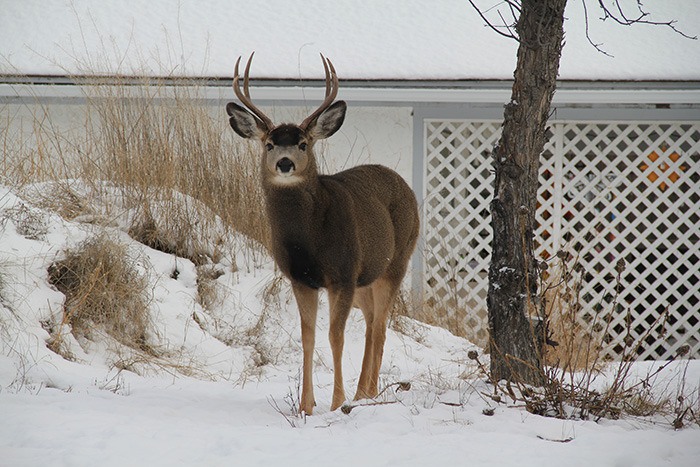The District of Invermere (DOI) has set funding aside for the relocation of 100 urban deer and is looking for a group to get the job done.
On January 8, DOI council voted to authorize funding for the development and implementation of a provincially-permitted relocation program to any group, local or otherwise, that meets the necessary criteria.
“I think this is a good move, reaching out to those who have been in disagreement with the DOI,” said Councillor Paul Denchuk.
Conditions of the newly-approved funding include a maximum of 100 deer to be removed from the community at a maximum cost of $300 per deer before the end of 2014. The successful group must secure a valid relocation permit from the Province of British Columbia as well as provide liability insurance and a waiver to protect the district from all liability and claims. A final report to the district regarding the outcome of the relocation is also a requirement.
Relocation was originally agreed to by council in 2011 as part of the two-pronged strategy recommended by the DOI’s Urban Deer Committee that included the culling of up to 100 deer. For budget reasons, the district opted to proceed with the cull in 2012, stating that guidelines for relocation would be put in place in 2013. Community protests, tampering with traps, and a civil suit filed against the district by the Invermere Deer Protection Society (IDPS) ensued. An injunction obtained by the IDPS from the Supreme Court of
B.C. also temporarily halted the cull, which killed just 19 deer before the district’s provincial permit expired. As a result of the lawsuit, approximately $36,000 in legal costs have been incurred by the DOI to date. With tentative court dates set for late January and early February, Mayor Gerry Taft hopes a decision on the district’s culling bylaw will come sooner than later.
“I think the worst case situation is that this just gets delayed and delayed and delayed,” he said. “Obviously there are two sides that have their own positions and beliefs and each side believes they’re in the right but it would be great to have that information come before the court and to have everything dealt with and have some clarity and some decision made.”
Meanwhile, in attempting to follow through with part two of the original deer management recommendation, the district has discovered how difficult it is to secure a relocation permit.
“It was just found easier that if another group is that interested, that they should take that on,” said DOI chief administrative officer Chris Prosser.
Yet the IDPS does not support relocation as a solution either. In a report to district council, the IDPS included excerpts from a Ministry of Environment analysis to the effect that mortality following capture, transport and release can be “substantial”. A statement on urban deer by the BC SPCA also included in the report states that the stress of capture and transportation not only leads to high mortality and fatal injuries, but the inability to adapt to unfamiliar territory and naivety to new predators.
IDPS president Devin Kazakoff said his organization’s opposition to relocation is two-fold. First, the IDPS maintains there is not an overpopulation of deer in Invermere. Second, if overpopulation is in fact legitimately determined, then it should be done using non-lethal solutions. Relocation isn’t necessarily non-lethal, he said.
“You can take it that as you’re moving them, you’re not killing them but with the high percentage of mortality, it kind of is a lethal solution,” Kazakoff said.
The DOI has agreed to work with the IDPS and come up with positions on other options such as hazing, birth control and fencing.
“I don’t think relocation is a great option but maybe if it’s studied it can work, I’m not sure,” said Taft. “But I hope through the process that every single time an option is brought up it isn’t attacked each time because we need to still try to work together and find some options that might have a chance of success.”
“For me, I don’t think the cull is off the books at this point and it’s still one of the options that’s out there,” said Councillor Greg Anderson.
Three counts done by the DOI’s Urban Deer Advisory Committee on consecutive Saturdays in November recorded 185 initially, 205 a week later with 148 recorded for the final count. For each respective count, over 100 were does, roughly 50 were fawns and less than 30 were bucks. At a Committee of the Whole meeting on OCtober 2, council recommended that no referendum regarding deer take place in 2013 and that staff and Council should start the process of implementing an education program in 2013.
